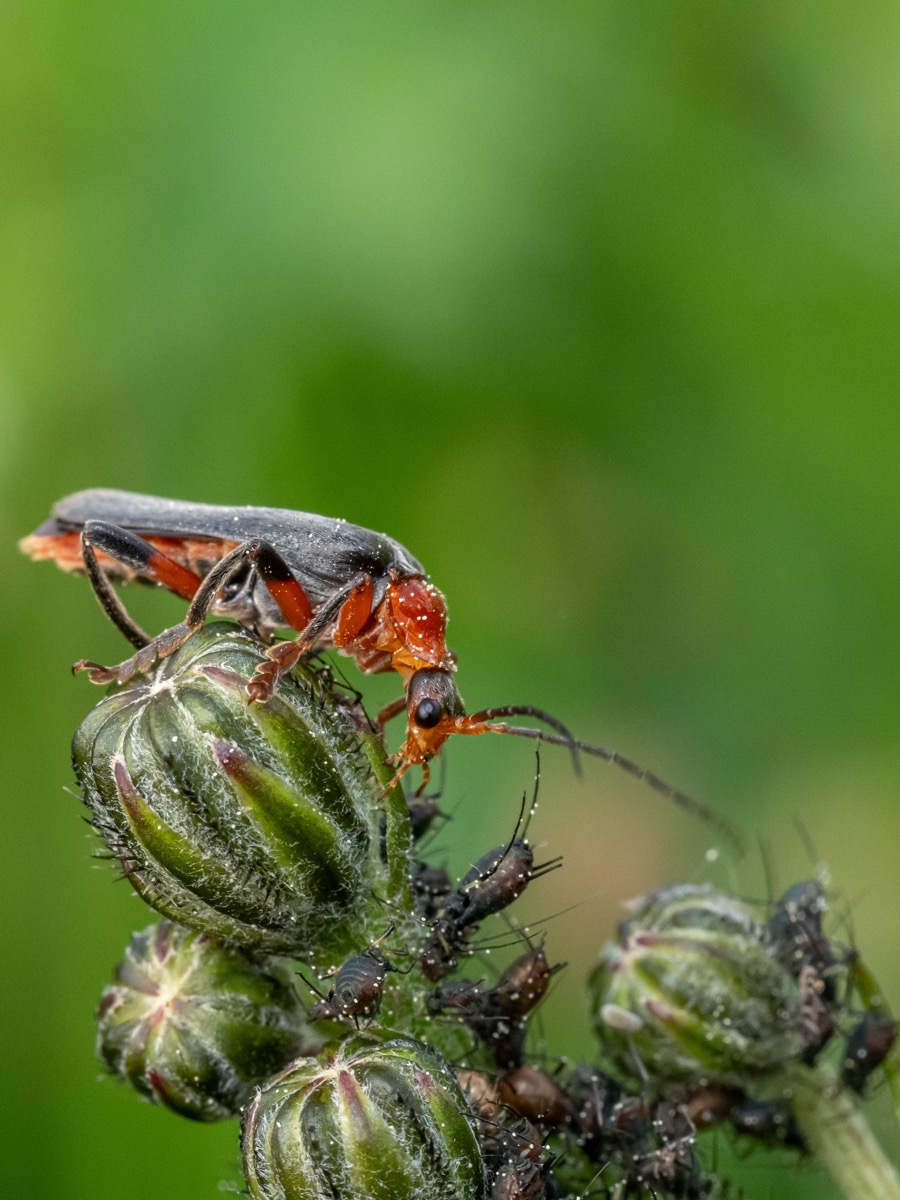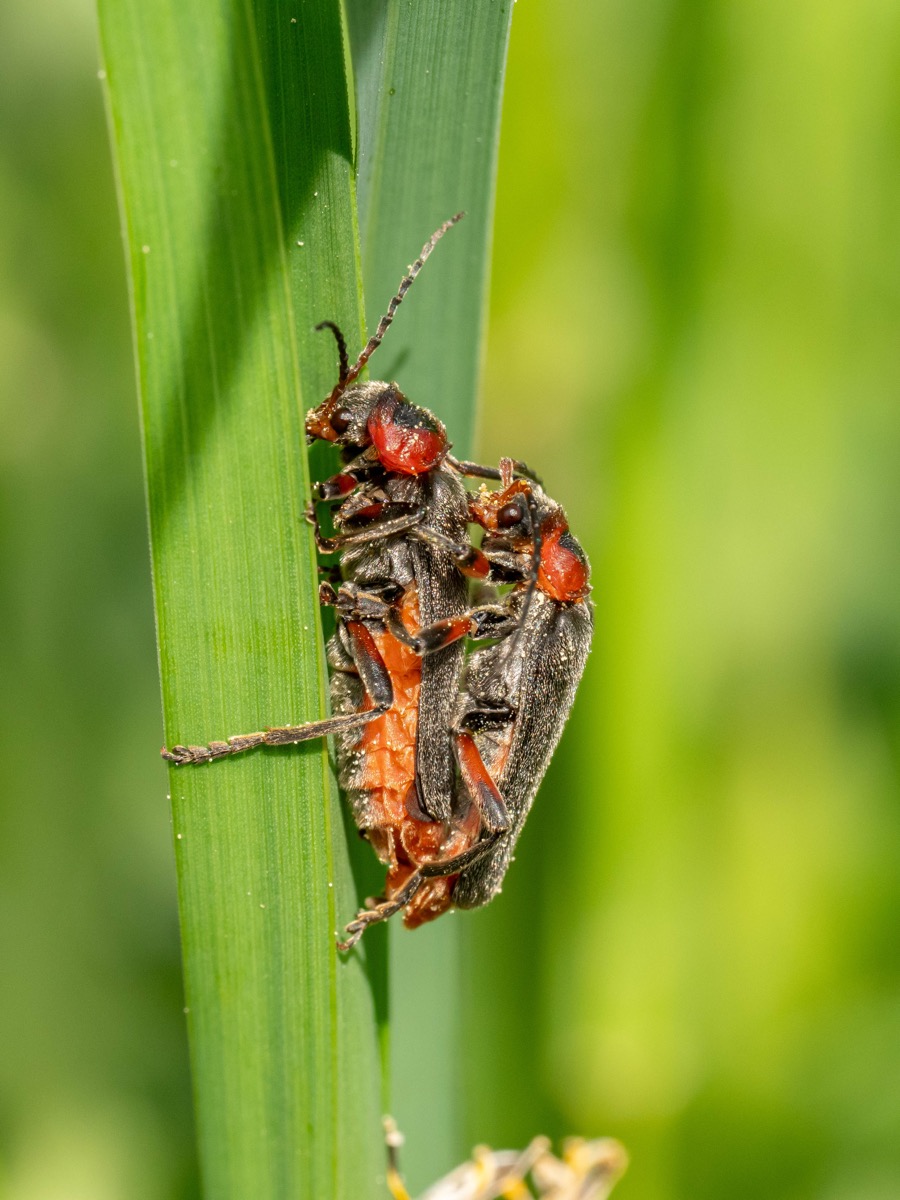The Cantharidae – Soldier Beetles
The Cantharidae – Soldier Beetles are closely related to fireflies and glowworms but cannot produce light.
Notable Features
- Size up to 15 mm
- Well-visible eyes
- Long, segmented antennae
- Female: seven abdominal segments
- Male: eight abdominal segments
The Cantharidae, commonly called “soldiers” or “leatherwings”, are a family of beetles belonging to the order Coleoptera. This family includes over 4,000 described species and is characterized by several distinctive traits. Here is a summary of the main features and aspects of Cantharidae (soldier beetles):
Characteristics
Appearance and morphology:
Cantharidae generally have an elongated, soft, and cylindrical body. They often exhibit bright colors such as yellow, orange, or red, which may serve as a warning to potential predators due to their possible toxicity.
Chemical defense:
Cantharidae sometimes contain toxic chemical substances, notably cantharidin, which can cause burns and irritation on skin and mucous membranes. These substances also serve as a repellent against predators.
Diet:
Cantharidae are primarily predators. Their diet generally consists of smaller insects, including aphids, larvae of other insects, and various arthropods. They play an important role in regulating pest insect populations.
Life cycle:
Cantharidae go through several developmental stages, from egg to larva, pupa, and adult. Larvae are often active and predatory, living in various habitats such as soil, leaf litter, trees, or even aquatic plants. Adults also feed on smaller insects.
Reproductive strategies:
Cantharidae may have different reproductive strategies. Some species lay their eggs on plants, while others deposit them in soil or on specific substrates. Larvae may develop in various habitats depending on the species.
Habitats:
Cantharidae are found in a variety of habitats such as meadows, woodlands, wetlands, and coastal areas. Some are also attracted to lights at night, which may bring them close to human dwellings.
Ecological importance:
As predators, Cantharidae play a key role in controlling pest insect populations, thus helping to maintain ecological balance in various ecosystems.
Cantharinae (subfamily)
Genus Cantharis
Cantharis livida
| Order | Coleoptera |
|---|---|
| Family | Cantharidae |
| Genus | Cantharis |
| Species | Livida |
| Common name | Livid Soldier Beetle |
| Identifier | Linnaeus |
| Year identified | 1758 |
| Protected | Not protected |
| IUCN category (2001-2003) | Not classified |
| Habitat | |
| Diet | |
| Color | |
| Antennae | |
| Pronotum | |
| Elytra | |
| Legs | |
| Range | Europe |
| Min size | 13 |
| Max size | 15 |
| Period start | April |
| Period end | August |
Cantharis rustica
| Order | Coleoptera |
|---|---|
| Family | Cantharidae |
| Genus | Cantharis |
| Species | Rustica |
| Common name | Rustic Soldier Beetle, The Monk |
| Identifier | Fallen |
| Year identified | 1807 |
| Protected | |
| IUCN category (2001-2003) | |
| Habitat | |
| Diet | carnivorous, flower-visiting insects |
| Color | |
| Antennae | |
| Pronotum | distinctive black spot |
| Elytra | |
| Legs | bicolored femora, red and black |
| Range | from Europe to the Urals |
| Min size | |
| Max size | |
| Period start | April |
| Period end | June |

